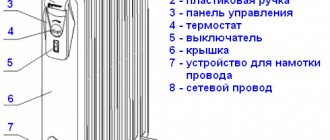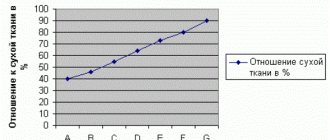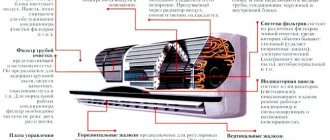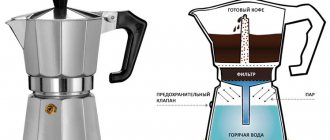At the same time, if earlier the choice was clearly in favor of oil radiators or small fan heaters, due to the lack of other safe alternatives, then recently convectors have become increasingly popular.
Now that there are options, many people begin to wonder before going to the store, which of these heaters is really the best? Is it worth spending money on a not-so-cheap convector or is it better to buy an old, time-tested oil pan?
Let's understand all the disadvantages and advantages of both devices.
Oil battery
This is perhaps the most classic type of heater. It works on the principle of heat transfer.
In this case, significant heat loss may occur.
After all, it first contains:
- heating element heats up inside
- then it heats up the oil
- only after this do the battery walls heat up
- and at the end, they transfer heat to the nearest space near the oil pan
Therefore, in order to warm up the entire room faster, it is initially placed almost in the center of the room. If you push it into a corner or lean it against the wall, you will wait a very long time for heat.
Moreover, the minimum distances from walls and from surrounding objects are usually regulated by the safety rules for placing such batteries.
If there is no air movement in the room, then until the heated volume of air space near the heater itself passes to the neighboring layers, and they, in turn, give off heat further along the chain, a very, very long time passes.
Of course, if you are sitting near the radiator itself, you will be hot. But as soon as you move to a sofa or chair, away from the radiator, the feeling of warmth suddenly disappears.
As a result, it turns out that a comfortable and uniform temperature in a relatively large room (living room, bedroom) cannot be achieved using an oil radiator.
Moreover, the bulk of the cold air flow is always located below. And the warm air from the radiator immediately rises, without in any way warming up the layer near the floor.
Therefore, even if you have such a heater in the room, you still have to constantly wear slippers.
The built-in mechanical thermostat is responsible for the question of the frequency of switching on and off oil batteries. Without such devices, it is generally not recommended to buy this type of heater.
So, due to the fact that the air near the battery itself is constantly warmed up much more than in the entire room, its operation error of 3 degrees is considered almost the norm. Although sometimes it reaches 5-7C.
What problem does this pose for you personally? And the trouble here is that the oil engine simply does not have time to adequately respond to the rate of change in temperature outside.
As a result, you experience constant discomfort. The room will either be very overheated, or it will be periodically cool, even with the battery constantly on.
And the point here is not the heat loss of the room, windows or walls. Namely, the incorrect operation of the heating device.
Comparing the convector and oil radiator
What is better, a convector or an oil radiator?
To make the best choice of a heater, you cannot do without comparing various criteria, starting with ease of use and economical operation.
Comfort
Both types of heaters operate quietly and do not emit foul odors during heating. Some designs are equipped with a programmed operating mode, installation of start-up and shutdown.
What is important is that heat is exchanged unevenly during air dispersion - the difference in air heating near the floor and at the highest point of the room can be 10°C. Also, a convection heater in dusty rooms will drive sand particles and other debris throughout the space, which is not pleasant.
Economical
Before choosing an oil heater or a convector, you should remember that the first option has such a feature as thermal inertia. It takes a certain amount of time to raise and lower the temperature of the coolant.
Ultimately:
- Heating of the medium begins a certain period after the heating unit is started.
- The device retains heat transfer for quite a long time after being turned off.
- As a result, the radiator consumes a quarter more energy from the network compared to the convector.
But at the same time, the radiator is capable of maintaining higher air heat levels than the convector.
The radiator heats the room faster
The convector, naturally, is more economical and its service life is designed for a longer period, which is estimated at two decades. Whereas microcracks may appear on the body of oil heaters, as a result of which leaks appear and the service life is no more than ten years.
Compactness
Oil radiators and converters are available in floor-mounted and wall-mounted versions, but the dimensions of the second are usually smaller. When choosing a portable heater for short-term use, the weight of the product is important. Typically, convectors are half the weight and can be easily moved between rooms.
Safety
Mid-price heaters are equipped with electricity stabilizers, which protect the device from voltage surges. There are sensors that prevent the device from overheating and turn off the device in critical situations.
Radiators of cheap categories are not equipped with any protection, so they are used only with constant monitoring.
The surface of the convector heats up to approximately 60°C, making it almost impossible to get burned. At the same time, the metal body of the radiator can heat up to 85°C, and the possibility of injury is quite high if there is no protective casing. This is very important if there are children in the house.
Environmental friendliness
According to this important criterion, heaters are equally safe for the health of consumers. Dust settling on the surface is not exposed to high temperatures. Volatile poisonous inorganic compounds contained in paints and varnishes that cover the surface of the device are not released when heated.
Convectors can raise dust, causing allergies
Oil radiators differ only in that they raise organic and inorganic microparticles into the air to a lesser extent, as they are characterized by low convection rates.
Heating of large areas
To raise the air temperature in a large room, it will be necessary to use several oil radiators, each of which will require a separate electrical outlet.
The ability to combine convectors into one heating system is an undeniable advantage of these heaters. The network of devices is equipped with a rheostat, which reduces electricity consumption.
Cost and durability
Convectors have a service life of twenty to twenty-five years. These are reliable devices that can most often be repaired. Oil radiators can leak over several years of operation (up to 10 years) due to the occurrence of microcracks in the housing. After such a breakdown, they cannot be restored, and there is a need to purchase new devices.
Electrolux oil radiator
The price of the units depends on the brand and performance of a particular device. On average, heaters with oil are cheaper if we compare similar power and functionality indicators. Well-known brands have a high cost, and cheap analogues most likely will not last long.
In the absence of the opportunity to heat a house, cottage, or apartment with a solid fuel or gas boiler, consumers install mobile electric heaters. When choosing a device, it is imperative to take into account the efficiency of the unit at similar energy costs. Knowing the features of each type, you can purchase a device that will satisfy all the owner’s needs.
Electric convector
This unit operates on the principle of convection. That is, it gradually mixes layers of cold air in the room with hot ones. And all this happens without any fan.
The design of such heaters has a narrowed lower part and a wide upper part.
The heating element is located at the bottom. Moreover, there is nothing else inside the convector.
The air temperature in the “air pocket” of this battery before switching on is the same as in the entire room. But as soon as you plug it into a power outlet, in literally 1-2 minutes the heating element reaches its maximum temperature and warms up a “portion” of air inside the case.
According to the laws of physics, this heat rises upward, where it encounters built-in grilles or blinds on its way.
Colliding with them, warm air is redirected at a certain angle towards the floor, where it immediately mixes with the coldest layer in the entire room.
Moreover, please note that the shape of the air distribution louvers can have a significant impact on the entire operation of the device. For example, in those devices where the blinds are similar to the wings of butterflies, the air will always be hot both from above the convector and from below.
But in models with a fine mesh, the body at the top is usually very hot, and at the bottom it will be just warm.
Thus, in some models, the heated stream of air does not immediately rise to the ceiling, but is constantly mixed with cold streams, creating approximately the same temperature throughout the room.
In general, remember that the uniformity of heating of the room does not depend on the type of heater, but on the intensity of air mixing in it.
Moreover, convectors are produced that can not only mix warm and cold air, but also purify it. The presence of all kinds of filters helps in this - anti-dust, carbon, biologically active with vitamin C, etc.
But since these are consumables, sooner or later they have to be replaced. Imagine that in the future such filters will be discontinued? What will you do?
Therefore, you shouldn’t bother too much here, and it’s easier and cheaper to choose models without fancy cleaners, ionizers, sterilizers, etc.
Convector heaters
At the first glance at heaters of this type, their flat and even body shape catches your eye.
Most often, such heaters are supposed to be attached to the surface of the walls, but there are also floor-mounted options. Moreover, the latter are equipped with swivel wheels for ease of movement around the room. Some models can be either wall-mounted or floor-mounted. The so-called plinth convectors look interesting; they have a very small height (from 15 cm), but their length can reach up to 1.5 meters.
The required temperature level in the room is maintained using a thermostat. Unlike the considered oil appliances that emit heat, convectors heat the room by moving air flows of warm and cold air. There are holes in the lower and upper parts of the convector body. Having heated up from the heater, warm air is discharged out through holes in the upper part of the case, and instead of it, a new portion of cool air arrives from below. Thus, due to constant air circulation, the rooms are heated. At the same time, the operation of convectors is almost silent, and the room heats up quite quickly.
A convector mounted on the wall takes up virtually no space in the room and does not interfere with movement around it, which is especially important if there are small children in the family. In addition to options for the home, you can find convector heaters for offices and industrial premises on sale.
Heating of a room with the help of convectors is carried out due to the fact that warm, less dense air rises to the ceiling, and denser cold air settles to the floor. Such movement of air flows in rooms is called convection, which is reflected in the name of heating devices operating on the basis of this principle.
The design of the convector heater includes:
- a convection chamber, which is also the body of the heating device;
- heating element built into the housing.
When the device is turned on, cool air entering the convection chamber is heated by the heating element. At the same time, its density and weight decrease and it is brought out through the holes at the top. And the vacated space inside the convection chamber is occupied by another portion of cool air.
The holes in the upper part of the body are directed in such a way that the heated air does not immediately go up, but is discharged out in a horizontal plane. In this case, warm air does not leave the convector immediately, but gradually accumulates, receiving some excess pressure.
The required air heating temperature is set using a thermostat. It is he who turns the heating element on or off at the right times. The efficiency of a convector heater is very high.
The convector heating element is mounted in a special way, so you do not need to worry about grounding this device during operation. This is achieved due to the fact that the heating element does not have direct contact with the metal body. The heating element is separated from the body by special stops made of heat-resistant plastic.
The convectors are designed in such a way as to ensure uniform distribution of warm air in the room. And this makes any living space warm, comfortable and cozy.
Let us note several obvious advantages of convector heaters:
- The presence of an electronic thermostat and various operating modes allows significantly
reduce energy consumption.
- Convectors installed in all rooms of an apartment or house can perform the function
complete heating system.
- Convectors meet all fire safety and environmental requirements.
Temperature control and power consumption
Convectors, like oil batteries, have their own mechanical thermostat. However, its error due to the correct mixing of cold and warm flows near the heater itself is minimal and amounts to less than 1 degree.
Due to more accurate operation of the thermostat, the continuous operation time of the convector is also adjusted. This results in greater energy efficiency and lower power consumption.
At the same time, the air in the room warms up more evenly. You won’t have too much of a temperature difference in different corners, even if you don’t place it in the middle of the room, but hang it close to some wall.
If you don’t really trust all these stories about efficiency, just compare the energy efficiency or energy saving class of oil heaters and convectors. On stamps from leading brands, it is usually indicated.
So, even the best oil coolers have the worst class - D. And for convectors, it is usually no lower - A. There are some models with the highest class - A+++.
In some European countries, it is even officially prohibited to sell and plug in such electrical appliances with an energy efficiency class below A.
Oil heaters, their design and operating principle
The main difference from the previous type of heating devices here is the presence of a coolant, which is mineral oil.
Next we will look at the features of oil heaters. They are already less compact heating equipment, powered by an electrical network. Already from the name alone it is clear that inside these aggregators there is mineral oil. It acts as a coolant, distributing heat over the entire area of the device - and the fin area here is larger than in conventional convectors.
An oil heater and an oil convector are one and the same. Thermal radiation from oil models is weak; the rooms are heated using the same natural convection . Inside these units there are sealed heating elements that are immersed in oil. That is, we see here an intermediate element responsible for heat distribution.
In general, the principle of operation of oil heaters is the same as that of convectors - heated ribbed housings heat the air, as a result of which it rises, displacing colder air masses down. The result is gentle mixing of the air while simultaneously heating it.
There are two types of similar devices available for consumers to choose from:
- Wall-mounted oil convectors are quite expensive electrical appliances for permanent installation. In appearance, they are somewhat reminiscent of steel panel radiators;
- Floor-mounted oil radiators are cheap equipment equipped with removable or non-removable legs. Most often they are used as auxiliary equipment when the main heating is not working well enough.
Wall-mounted oil radiators are easily confused with conventional radiators.
Oil radiators warm up rooms quite quickly, using electricity from a single-phase electrical network. To ensure that a certain temperature is maintained, wall and floor models are equipped with thermostats, most often mechanical. To reduce the load on the electrical grid, step power switches are often located on board.
Let's look at the main advantages of this equipment:
- The oil convector has a simple design - there is practically nothing to break here (however, as in the convectors described above);
- Relatively light weight - allows for easy movement of units around the apartment;
- Wide power range - oil heaters with a power of up to 2.5 kW are available for sale, which is enough to heat a room of 20-25 square meters. m.
The control in oil radiators is most often mechanical, although there are examples with electronic push-button control.
In the case of using oil radiators for independent use (without main heating), a good power reserve should be provided - this is due to their low efficiency.
Convector safety and maximum heating
Another advantage is the heating temperature of the walls. The body of the convector itself never heats up to such temperatures as oil radiators.
You don’t have to constantly monitor and worry about your children so that they don’t accidentally get burned.
Well, if the thermostat accidentally breaks down in the oil pan, this can lead to overheating of its walls and the formation of microcracks. If these cracks are in the upper part, then the oil will gradually begin to evaporate in the room. And you will breathe all this every day.
If the crack is from below, then the liquid will gradually flow out of the device. And even then, this type of breakdown can be considered a happy accident.
When no such crack has formed, the battery simply bursts due to internal pressure, and boiling oil begins to gushing out in all directions.
Of course, branded oil radiators (Electrolux, Zanussi, Ballu) use non-flammable synthetic oil. But this will not make it any easier for you.
With convectors you are freed from such problems once and for all. The maximum that can happen is that the heater will consume more energy than usual.
Technical parameters of convectors
There are different types of water and electric convectors. The former require installation of a pipeline, so it is more logical to compare them with water heating radiators. When considering which is better, a convector or an oil heater, attention is paid to electric models of convectors, which are powered by a 220 V power supply and connect to a standard outlet.
An electric convector in a floor or wall version is made of sheet metal - the unit’s design is simpler compared to a radiator. Cold air, during natural circulation, is sucked in through the lower openings, passes past the heating plates, and exits through the openings in the upper part of the housing.
Operating principle of the convector
The difference between a convector and an oil radiator primarily concerns the operating principle
. A little heat is radiated by the body, while the main part of the thermal energy is transferred through convection - convective fins provide heating and intensive movement of air masses.
How does a convector differ when comparing operating efficiency? Since the metal is directly heated, which gives off heat, a convector heater is characterized by an efficiency close to 100%.
Electric convectors are equipped with a thermostat that regulates the intensity of heating the room, focusing on the air temperature. If the convector's upper slots are sloping downwards, the flow of hot air is directed towards the floor and distributed over the entire area, due to which the unit heats the room more evenly.
Convector control units - which one is better
And for greater efficiency, convectors can be equipped with:
- electronic control unit
With it, the heater becomes up to 40% more economical than an oil heater.
- or inverter
Cost efficiency reaches 70%. For greater clarity, imagine a car driving uniformly along a highway at the same speed. This is an inverter.
Without it, the heater will resemble a car moving through traffic jams in the city. Who do you think will have more fuel consumption for the same mileage? It's the same with convectors.
The point of inverter units is that the heater “understands” what the general temperature is in the room. Correlates it with the specified parameters and, based on these data, regulates the power of the work.
That is, the device does not operate at maximum power all the time, as is the case with the classic mechanical version. Here, heating first occurs to a given temperature, and then to maintain it, the maximum power is not used at all.
This is precisely what inverter technology is all about, due to which the efficiency of such models is achieved.
Here's supporting documentation and real-world test data for all of the above claims. All with signatures, seals, etc.
Convector tests and conclusion
With such units, you can regulate the temperature in the room with an accuracy of tenths of a degree.
Another advantage of convectors is the versatility of their placement. Most of them have wheels for moving around different rooms of the apartment.
So is the stationary type of fastening. With its help, the convector is placed on any wall in the form of a battery.
However, be careful about one thing. Some people attach foil or other shiny reflective material to the wall behind the heater body. This should supposedly help reflect heat and improve heating.
However, if your model has a temperature sensor at the top, then this foil will cause it to overheat. Accordingly, the convector will not work correctly and will not heat the room a little.
For devices with a bottom-mounted sensor, such a reflective surface has little effect on its operation.
But no one hangs oil batteries on the wall at all. In the summer, they constantly get in the way, or take up extra space on the balcony or in the closet.
So it turns out that if you place it in the same conditions - the same room area, the same initial temperature, the same operating time, two heating devices, then the convector will ultimately outperform the oil battery in all respects.
Here are real reviews from users who switched to fully heating their homes with convectors.
What is more economical, a convector or an oil heater?
What is better for saving money, a convector or an oil heater? The efficiency of both devices is almost the same and approaches 100% (like other direct-heating electric heaters). Almost all consumed electrical energy is converted into heat and remains indoors. But due to the difference in operation, an oil heater uses a little more energy to maintain the same temperature.
When the convector is turned on to maintain a certain temperature, it quickly reaches the required value and turns off. For example, it is required to ensure a constant temperature of 20 degrees in the room. When the convector is turned on, it almost immediately enters operating mode and begins warming up.
Having reached the set temperature, it turns off and cools down. The air cools and the thermostat activates, turning the device back on. The temperature difference when turning the device on and off will whistle due to the accuracy of the thermostat - electronic ones are more accurate. When the oil cooler is operating, there is greater inertia. When turned on and set to the same temperature, heating begins with a significant delay. In some models, the set mode is reached after 20 minutes. At this time, the oil warms up.
When the radiator has reached operating temperature, it completely transfers heat into the room. Just like in a convector, when it reaches 20 degrees (for example), the thermostat turns off the power from the heating element. But the heater still remains hot and continues to transfer heat into the room. Its cooling occurs as slowly as its heating. The temperature in the room becomes higher than the set one, heat loss through the building envelope increases. Due to this, energy consumption increases.
Convector on legs.
When, after a certain period of time, the room temperature drops to the thermostat setting value, the power turns on, but since the oil also heats up slowly, during the warm-up period the room temperature does not rise or falls further. The cycle repeats - the radiator enters operating mode.











